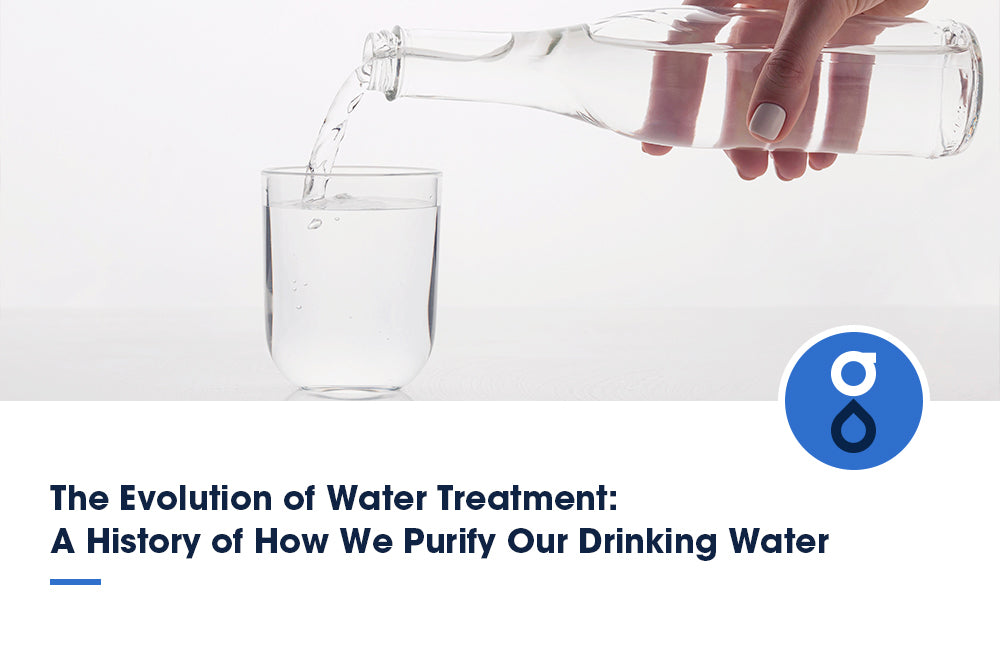Table of Contents:
Early history of water treatment
Developments in filtration technology
Advancement in disinfection technology
Monitoring and Testing Improvements
FAQs
conclusion
Treating water to make it safe for drinking and other uses is one of humanity’s most important innovations. Without the ability to purify water from microbes, chemicals, and other contaminants, we would be plagued by outbreaks of serious diseases like cholera, typhoid, dysentery, and hepatitis. Over thousands of years, water treatment methods have evolved as new technologies were introduced to remove an expanding range of pollutants. This article will explore how drinking water purification has developed and highlight key breakthroughs shaping modern municipal water systems.
Early history of water treatment
Ancient civilization`s water treatment

Some of the earliest evidence of water treatment comes from ancient Greek and Sanskrit writings, which described techniques like boiling, filtration through charcoal, exposure to sunlight, and straining water through cloth.
Boiling- Heating water to a high temperature kills harmful bacteria and pathogens, making it safe to drink.
Filtration- Passing water through materials like sand, cloth, or charcoal helps remove impurities and particles.
Sedimentation- Allowing water to sit in a container allows heavier particles to settle at the bottom, leaving clearer water above.
Chemical Treatment - Using natural substances like alum or copper sulfate, ancient civilizations would add these chemicals to water to precipitate and purify impurities.
These basic methods helped eliminate bacteria, parasites, and larger particles from drinking water. By letting water sit in large containers, heavier contaminants would also settle to the bottom in sedimentation.
Early settling and filtration methods

Try using early settling and filtration methods to remove impurities from your drinking water. In ancient times, people relied on simple yet effective techniques to ensure the cleanliness of their water sources. These settling techniques involved allowing the water to sit undisturbed, allowing heavier particles to sink to the bottom, while the lighter ones floated to the surface. Primitive filters made from materials such as sand, gravel, and charcoal were also used to trap impurities. These prehistoric purification methods may seem rudimentary compared to today's advanced technologies, but they served their purpose well. By incorporating these early methods into your water treatment routine, you can appreciate the ingenuity of our ancestors and ensure the safety of your drinking water.
The first application of chlorine
Chlorine was discovered to have disinfecting properties in the 1800s and was first used as a germicide for drinking water supplies in the early 1900s. This disinfection technique breakthrough revolutionized how we treat water and protect ourselves from waterborne diseases. Here are four key reasons why chlorine is a crucial chemical additive in water treatment:
1. Effective disinfection: Chlorine kills harmful bacteria, viruses, and parasites that can cause diseases like cholera and typhoid fever.
2. Residual protection: Chlorine leaves a residual effect in water, continuing to kill any microorganisms present as the water travels through the distribution system.
3. Cost-effective: Chlorine is a cost-effective disinfectant, making it accessible for large-scale water treatment.
4. Familiarity and trust: Chlorine has been used for over a century, building public trust in its ability to ensure safe drinking water.
Developments in filtration technology
Sand filters in the 1800s
By the late 1800s, slow sand filters processing large volumes of water became a common technology in municipal treatment systems. The thick filter beds of sand effectively eliminated parasites and microorganisms. Here are four reasons why sand filtration techniques were so successful during that time:
1. Simple yet powerful: The sand filtration process involved passing water through sand layers, effectively removing impurities and contaminants.
2. Natural purification: Sand has natural properties that trap particles and bacteria, making it an ideal medium for filtration.
3. Cost-effective solution: Sand filtration systems were relatively low-cost to implement and maintain, making them accessible to a wider population.
4. Improved water quality: By removing sediment, sand filters greatly improved the taste and clarity of drinking water, making it safer and more enjoyable to consume.
Overall, the introduction of sand filtration techniques paved the way for future advancements in water treatment, ensuring that we have access to clean and safe drinking water today.
Activated carbon filters in the 1930s

In the 1930s, the introduction of granular activated carbon filtration greatly improved the removal of organic chemical contaminants, colors, and odors. Activated carbon is a highly effective method for removing impurities from our drinking water. It works by attracting and adsorbing contaminants onto its porous surface. When water passes through activated carbon, it captures and holds onto impurities such as chlorine, volatile organic compounds (VOCs), and heavy metals. This process not only improves the taste and odor of the water but also reduces potential health risks. Activated carbon is commonly used in water treatment plants and home filtration systems. It is particularly effective in removing organic compounds that can be found in industrial waste and agricultural runoff.
Advanced membrane filtration emerged in the 1950s
In the 1950s, advanced membrane filtration processes like reverse osmosis were developed. Membranes with microscopic pores can filter out ions and even microscopic organisms. Reverse osmosis descales water through a semipermeable membrane against an osmotic gradient. This produces pure deionized water, effectively removing microbes, salts, metals, and other contaminants. Continued membrane technology improvements and reduced costs have made ultrafiltration and nanofiltration more affordable for drinking water systems. These membrane filtration methods provide more choices when targeting specific contaminants in source waters.
Here are four key points to understand the significance of this development:
1. Reverse osmosis: Advanced membrane filtration utilizes the principle of reverse osmosis, where water is forced through a semi-permeable membrane to separate impurities from the water molecules.
2. Nanofiltration: This advanced filtration technique employs nanoscale membranes with smaller pore sizes than conventional filtration methods. This allows for removing even smaller particles and contaminants from the water.
3. Increased efficiency: Membrane filtration offers a more efficient process, requiring less energy and producing less waste than traditional methods like activated carbon filters.
4. Improved water quality: With advanced membrane filtration, we can achieve higher-quality drinking water by effectively removing contaminants such as bacteria, viruses, chemicals, and heavy metals.
Advancement in disinfection technology

Chlorine remains the most commonly used water disinfectant in the U.S., but other alternatives have emerged. Ozone, generated onsite from oxygen gas, is a powerful disinfectant that leaves no chemical residuals. It has been used extensively since the 1970s in the U.S. and Europe. However, it requires high capital investment and leaves no residual disinfectant. Ultraviolet (UV) light disinfection is also gaining use as it effectively neutralizes pathogens. It involves no chemicals but requires electricity and clean water. Chloramines are favored over free chlorine for secondary disinfection since they reduce disinfection byproducts.
Monitoring and Testing Improvements

Advancements in monitoring and testing have greatly improved the accuracy and efficiency of ensuring the safety of our drinking water. With improved testing methods and automated monitoring systems, we can now detect contaminants more effectively and take prompt action to protect public health. Here are four key benefits of these advancements:
1. Enhanced accuracy: The new testing methods have increased the precision of water analysis, allowing for detecting even trace amounts of contaminants. This ensures that any potential risks are identified and addressed promptly.
2. Real-time monitoring: Automated monitoring systems continuously collect data on water quality parameters such as pH, turbidity, and chlorine levels. This real-time information enables quick responses to deviations from water quality standards, minimizing potential health hazards.
3. Early warning systems: By analyzing data trends and patterns, automated monitoring systems can provide early warnings of potential water quality issues. This proactive approach helps prevent contamination incidents and protects communities from harmful substances.
4. Regulatory compliance: Improved testing methods and monitoring systems help water utilities meet and exceed water quality standards set by regulatory agencies. This ensures that our water meets the highest safety standards and protects public health.
FAQs
How has the evolution of water treatment affected the taste and odor of drinking water?
Water treatment techniques, purification methods, and filtration processes have greatly improved the taste and odor of drinking water. With advancements in technology, you can now enjoy clean and fresh-tasting water at home.
How does the early history of water treatment differ across different world regions?
The early history of water treatment differs across regions due to comparative analysis of cultural practices and technological advancements. Cultural practices shaped purification methods, while technological advancements varied based on available resources and knowledge.
What role do public awareness and education play in the success of modern water treatment practices?
Public awareness and education are crucial to the success of modern water treatment practices. You can improve water quality by understanding the importance of clean drinking water and the methods used to purify it.
Conclusion
Today's technology used to treat and disinfect public drinking water would have been unimaginable to ancient civilizations struggling with unsanitary water sources. As new chemical threats emerge and environmental regulations tighten, water utilities will continue adopting more advanced treatment methods. However, time-tested techniques like filtration and chlorination remain central to the multi-barrier defense against waterborne illnesses. Water treatment continues to evolve as we learn more about the factors that can compromise drinking water quality and public health.

















